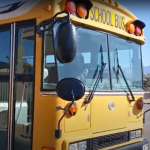After spending a several days serving on jury duty, I began to wonder about a few school policies and how they are practiced and / or implemented within different districts and schools.
I wonder how different schools track or input discipline. Do all schools follow the same or similar practices? What procedures are in place? We follow board policy that states, “The principal of each school shall ensure that a copy of all rules pertaining to discipline, suspension, and expulsion of pupils are distributed to the parents of each pupil at the time the pupil is enrolled in school. The principal of each school shall ensure that all rules pertaining to the discipline, suspension, and expulsion of pupils are communicated to students at the beginning of each school year, and to transfer students at the time of their enrollment in the school. Information concerning a student’s disciplinary record will be held in the strictest confidence. Disciplinary actions taken will be recorded in an administrative log, and all types of suspensions or expulsions will be recorded in a separate file for each student.”
But what does that mean for a district or each school? What does discipline look like within each classroom? Is it uniform and fair for all students? Does it vary teacher to teacher?
I wonder how schools track and make decisions about retention. We follow board policy that states, “Retention of students is a process that is followed when the professional staff, in consultation with the parent, determines it to be in the best interests of the student. Though primary grades are suggested as the most appropriate time, retention may be considered at any grade level. When circumstances indicate that retention is in the best interest of the student, the student will have individual consideration, and decisions will be made only after a careful study of facts relating to all phases of the student’s growth and development. The student’s academic achievement level and mental ability are important, but physical and social characteristics are also important factors. A decision should be based on sufficient data, collected over a period of time and motivated by a desire to place students in school programs where they will be the most successful.”
So what does that mean for a district or at the school level? What criteria are used to determine whether a student will be promoted or not? Are we all using the same standard measures or indicators? Again does it depend on the teacher or class? Once a student and their parents are given a letter of retention, what happens? By that I mean does their mindset shift? Do they go into fight mode or passively except that they have failed? In what ways does this process impact a teacher and how he / she supports a student? What are the intended and unintended consequences of retention?









Comments 5
Oh man, retention is such a hard one. I’ve held so many different opinions on it I don’t even remember what one I’m on now. I see middle school students who are so far behind they have a tiny chance of being successful in high school. But by the time they get to me, their attitude is so often so bad either because their so mad or because they’re so down on themselves, that holding them back would likely just confirm their preconceived notions and not motivate them to do much better. Or they’ve developed mechanisms to pass that don’t include academics and get by unnoticed for so long but don’t ever really learn anything and end up dropping out.
Hi Sandy
Thanks for your insight. I agree. Retention is a hard one… I wonder if it is looking at more of an intervention related to academics, attitude, motivation. I’m not sure what the answer is except what we are doing isn’t necessarily working the way we intend it to.
Lots of great questions posed here. In a way, it all goes back to the idea of equity. Is it the same, consistent, or case by case that is the most fair. In reality its is some combination of all three, but then who’s subjective opinion is that navigation based on. ??? There is a lot of food for thought around the consequences that go with discipline and retention. It makes such a difference for both children and educators.
Looks like the hunt for good answers and solid practices continues…..
As a secondary educator, the idea of retention was interesting as I was reading this post… when kids get to my neck of the woods, they move on to the next grade and then spend time at night, during summers, or as a 5th year senior making up credits for failed classes. On the discipline note, we deal with making decisions that are best for students; the first considerations are, obviously, the degree of the offense, laws, safety, etc. After that, we work to make decisions that are fair and just and – yes – differentiated for each student. It is lots of work when done right; our Assistant Principal of Student Success and Safety, our campus Resource (police) officer, our security team, and our crisis and intervention teams work full-time (24-7) to keep up with all of the differing needs student bring on a campus our size. Thank you for reminding us of the board policy language to help us know we’re on the right track! PS: look up “restorative justice” if you haven’t already – it’s the direction our district is moving in to help with the healing and social parts of discipline.
Great questions and the answer is “yes.” To all of them. I sometimes feel that our policies have too many undefined terms (what does “mutual decision” mean? How about “will consult with” or “use the materials provided by the district as primary resources?” What’s a primary resource?) I think the policies you identified are definitely bent by contexts. Sometimes this is wise, sometimes it makes me wonder why we have them at all. Good post!